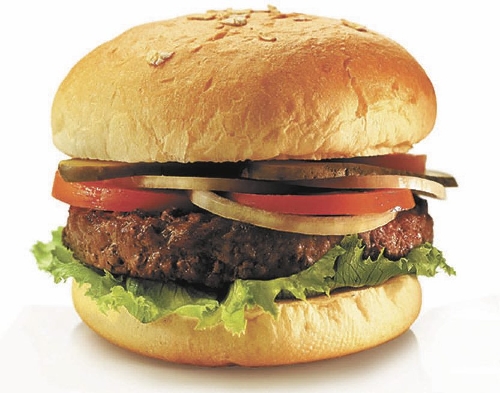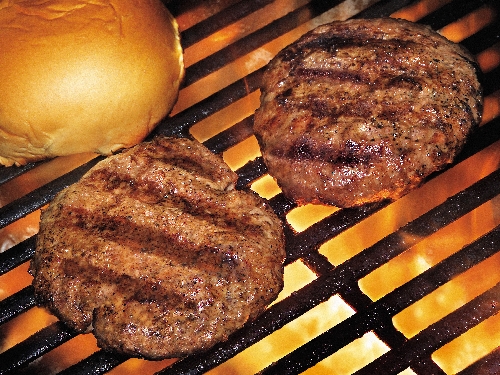Experiment with different beef for better burger flavor



Across the country, the Memorial Day weekend traditionally kicks off the summer barbecue season. Normally, that doesn’t mean much in hot-and-sunny Southern Nevada, but a cool spring has us thinking about our grills, too.
We don’t want to forget the reason for Memorial Day, but we don’t want to forget our cookouts, either. And if you’re planning to flip burgers on the grill this weekend, there are a lot of choices in the beef section of the supermarket alone: Do you want 96/4 (percent of lean to fat)? Or 90/10, 85/15, 80/20?
Here’s a tip: If you want yours to taste like those in the upscale burger spots, don’t use ground beef at all.
“We use a few different cuts, for a few different reasons,” said Anthony Meidenbauer, corporate executive chef for Block 16 Hospitality, which operates LBS: A Burger Joint at Red Rock Resort.
Meidenbauer said LBS uses a mix that includes about 75 percent chuck. The chuck comes from the animal’s shoulder, and contains a lot of fat, which contributes a lot of flavor, he said. The other 25 percent of the mix comes from dry-aged steaks, usually sirloin, porterhouse or rib-eye. The steak pieces, he said, provide an “intense meaty, minerally flavor.”
LBS also uses a coarser grind — 5/8-inch instead of the standard 3/16, Meidenbauer noted.
“It gives more of a mouth feel to the ground beef instead of a mushy, homogenous mass that isn’t appealing,” he said.
Juan Zuniga, chef de cuisine at BLT Burger at The Mirage, said his kitchen uses an 80/20 blend of beef to fat, ground daily.
“You don’t want it to be too lean,” he said. “Otherwise, it dries out and turns into charcoal.”
He said BLT uses a combination of chuck, brisket and tri-tip.
“It gives it a nice, beefy flavor, where you know you’re eating a hamburger,” he said. “It’s juicy and tender and moist.”
He said they also occasionally run specials featuring a burger made exclusively of prime rib or steak.
Burgers may not be the first thing that come to mind when one thinks of Bradley Ogden’s eponymous restaurant at Caesars Palace, but the restaurant serves a great one. The secret?
“I would say, generally speaking, the fat is about 22 percent,” Ogden said. About 80 percent of the meat is chuck, with the other 20 percent coming from the restaurant’s steak trimmings. The meat is ground in-house daily.
Ogden said the use of chuck keeps the meat consistent in terms of fat content and general flavor. Of the rest, he said, “it’s because we have them available and also it’s another layer of quality. It’s steak, from our New York, rib-eye, Kobe. So the burger ends up tasting like steak rather than just like a burger.”
So how can you get better flavor from your backyard burgers?
“The No. 1 thing,” Zuniga said, “is people can grind it themselves or have their butcher do it. The flavor’s nothing like buying previously ground beef or premade patties.”
If you don’t have a meat grinder, he recommended using a food processor, pulsing small batches so it doesn’t turn to mush.
“We’ve played around with that,” he said. “It takes a while, but use small batches little by little to get the texture you want.”
“It’s always best to know the products you’re putting into your grind,” Ogden said. “If you want to set up your grinder at home, you can do the same thing.”
Oh, and one more thing.
“Of course, we do things to it that make it better,” Ogden said. “We put butter on it, it goes on our wood grill. Then we baste it with a red-onion butter, so it adds another flavor dimension. You want layer upon layer of flavor — homemade pickles, homemade mustard …”
Ogden has a cookbook coming out in the fall, and shared some of his recipes for homemade condiments, which follow.
Said Zuniga: “It’s a huge difference. You’ll know right away when you’ve bit into a freshly ground burger, instead of something that was prepared ahead of time.”
THE ULTIMATE BURGER
2½ pounds skirt steak or sirloin flap steak
1½ teaspoons salt
¼ teaspoon pepper
Accompaniments: homemade burger buns, homemade ketchup, homemade mustard, homemade pickle relish, lettuce and tomato.
Cut steak into 1½-inch pieces and season with 1½ teaspoons salt. Chill in a sealable bag 4 to 6 hours.
Rinse steak under cold water, then pat dry. Grind using a meat grinder with a 3/8- or ¼-inch die, or finely chop in a food processor. Form into 6 balls and flatten into patties about 1 inch thick and 4 inches in diameter. Chill until ready to grill.
Prepare grill for direct-heat cooking over medium-hot charcoal (medium-high heat for gas).
Season burgers with ¼ teaspoon pepper (total). Lightly oil grill rack. Grill burgers, covered only if using a gas grill, turning once, about 5 minutes total for rare or 6 minutes for medium-rare. (Burgers will continue to cook slightly once removed from grill.)
Serve in buns with lettuce, tomato and condiments.
Serves 6.
— Recipe from Bon Appetit magazine
Here are recipes for condiments you can use with your custom burgers.
RED WINE BUTTER
2 cups ¼-inch diced red onions
2½ cups red wine
2 cups balsamic vinegar
2 teaspoons Dijon mustard
½ teaspoon kosher salt
1 teaspoon fresh ground black pepper
12 ounces unsalted butter
Place the onions, wine and balsamic vinegar in a 2-quart heavy-duty saucepan. Bring to a boil, then lower heat and cook until reduced by three-quarters. Remove from heat and cool slightly.
Add the mustard, salt and pepper to the reduction. Place the butter in an electric mixer and, using the paddle attachment, mix until smooth. Gradually add reduction and blend very well. Place in a container, cover and refrigerate until needed.
Use for basting steaks or burgers.
Makes 2 cups.
— Recipe from Bradley Ogden
PEACH MUSTARD
About 3 peaches (enough to make 1½ cups peach puree)
¼ cup fresh lemon juice
2 teaspoons dry mustard
1 tablespoon mustard seeds, toasted and ground
½ cup Dijon mustard
¼ teaspoon kosher salt
¼ teaspoon fresh ground black pepper
½ cup fresh peaches, cut in ¼-inch dice
Rinse peaches under cold water, then cut in half and discard the pit. Put the peaches (skin and all) through a food mill, using a fine grated setting, or puree in food processor.
Place the puree in a wide, heavy-bottom, noncorrosive saucepan over medium heat for 5 minutes. Add the lemon juice and dry mustard and reduce to low. Cook slowly until puree reduces by half, about 15 minutes, stirring occasionally. Add the rest of the ingredients except the diced peaches and cook for 8 minutes. Remove from the heat and cool immediately over an ice bath. Fold in the diced peaches. Refrigerate until needed.
Makes 2 cups.
— Recipe from Bradley Ogden
BREAD AND BUTTER SWEET PICKLE CHIPS
2 pounds pickling cucumbers
1 medium yellow Spanish onion, peeled and thinly sliced
2 cups apple cider vinegar
3 cups water
3 cups sugar
1 tablespoon kosher salt
1 tablespoon celery seed
2 whole red chilies
1 teaspoon ground turmeric
½ teaspoon freshly ground black pepper
1 tablespoon pickling spices
1 ounce fresh ginger, peeled, cut into 4 thin bias pieces
Wash pickling cucumbers and then soak in ice water for two hours. Slice ¼-inch thick and place in a large bowl.
Combine the rest of the ingredients in a heavy-duty stainless-steel sauce pan. Bring to a boil, turn heat to low and simmer for 5 minutes. Pour over the cucumbers and let cool at room temperature (place a weight over pickles so they stay totally immersed in the liquid). Refrigerate for three days before serving. Store refrigerated.
Makes 5 cups.
— Recipe from Bradley Ogden
DILL PICKLES
2 pounds pickling cucumbers
2 cups apple cider vinegar
3 cups water
¾ cup sugar, granulated
1½ tablespoons kosher salt
20 garlic cloves, peeled
2 teaspoons mustard seeds
1 teaspoon fennel seeds
3 tablespoons pickling spice
½ teaspoon fresh ground black pepper
2 bay leaves
2 small dry red chilies
1 bunch fresh dill
1 medium white onion, peeled and quartered
Rinse cucumbers in cold water, then soak in ice water for two hours. Cut into long slices, approximately 8 per cucumber.
Combine the vinegar, water, sugar, salt, garlic cloves and spices and place in a heavy-duty stainless-steel saucepan. Bring to a boil, then reduce heat to low and simmer for 10 minutes.
Lay out the cucumber pieces, onion wedges and dill sprigs in a large stainless-steel bowl. Pour the hot liquid over the cucumbers and let cool at room temperature. (Place a heavy weight over the pickles to keep them totally immersed in the liquid.) Refrigerate for three days before serving, then store refrigerated.
Makes 1 quart.
— Recipe from Bradley Ogden
HOMEMADE KETCHUP
1 can (28 to 32 ounces) whole tomatoes in juice
1 medium onion, chopped
4 garlic cloves, chopped
2 tablespoons vegetable oil
1 teaspoon chili powder
½ teaspoon paprika
¼ teaspoon cinnamon
¼ teaspoon ground allspice
1 tablespoon tomato paste
½ cup packed light brown sugar
½ cup cider vinegar
Puree tomatoes with juice in a blender until smooth.
Cook onion and garlic in oil with ¼ teaspoon salt in a 4-quart heavy saucepan over medium heat, stirring occasionally, until golden, about 8 minutes. Add spices and ½ teaspoon pepper and cook, stirring frequently, 1 minute.
Add pureed tomatoes, tomato paste, brown sugar and vinegar and simmer, uncovered, stirring occasionally, until very thick, 45 to 55 minutes (stir more frequently toward end of cooking to prevent scorching).
Puree ketchup in blender until smooth (use caution when blending hot liquids). Chill at least 2 hours for flavors to develop. Keeps, chilled, 1 month.
Makes about 2¾ cups.
— Recipe from Gourmet magazine
Contact reporter Heidi Knapp Rinella at hrinella@ reviewjournal.com or 702-383-0474.


















